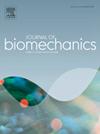Direction-specific response of shear traction forces generated underneath the hallux and lesser toes due to multi-directional perturbations applied in balanced standing
IF 2.4
3区 医学
Q3 BIOPHYSICS
引用次数: 0
Abstract
Existing experimental studies on human balance have primarily focused on biomechanical responses of major lower-limb joints, while the role of hallux and lesser toes of human foot in response to external perturbations has not been fully explored. Although toe grip strength may significantly influence balance performance, a more physiological-relevant toe grip evaluation, has not yet been established. This study investigates the biomechanical grip strength of the hallux and lesser toes during perturbations by quantifying the shear interactions (i.e., horizontal traction forces) at the foot–ground interface. A robotic platform with an instrumented multi-axial force platform was employed to analyze the involvement of the hallux and lesser toes in maintaining standing balance due to random ground perturbations. Our results indicate that hallux and lesser toes demonstrated significant direction-specific shear responses, and the proportion of shear traction force in the hallux and lesser toes significantly increased, particularly for perturbations in the posterior half-plane (p < 0.05). A substantial increase in shear traction force underneath the lesser toes was observed during contralateral perturbation events (p < 0.05). Importantly, the lesser toes could generate substantial shear traction forces by enhancing griping following perturbation, a capability not shown in other foot regions. This study introduced a novel approach for precisely quantifying the grip functions of individual toes at in-vivo perturbing conditions. The information provided is envisaged to have important implications on improved interventions for posture and balance rehabilitation.
求助全文
约1分钟内获得全文
求助全文
来源期刊

Journal of biomechanics
生物-工程:生物医学
CiteScore
5.10
自引率
4.20%
发文量
345
审稿时长
1 months
期刊介绍:
The Journal of Biomechanics publishes reports of original and substantial findings using the principles of mechanics to explore biological problems. Analytical, as well as experimental papers may be submitted, and the journal accepts original articles, surveys and perspective articles (usually by Editorial invitation only), book reviews and letters to the Editor. The criteria for acceptance of manuscripts include excellence, novelty, significance, clarity, conciseness and interest to the readership.
Papers published in the journal may cover a wide range of topics in biomechanics, including, but not limited to:
-Fundamental Topics - Biomechanics of the musculoskeletal, cardiovascular, and respiratory systems, mechanics of hard and soft tissues, biofluid mechanics, mechanics of prostheses and implant-tissue interfaces, mechanics of cells.
-Cardiovascular and Respiratory Biomechanics - Mechanics of blood-flow, air-flow, mechanics of the soft tissues, flow-tissue or flow-prosthesis interactions.
-Cell Biomechanics - Biomechanic analyses of cells, membranes and sub-cellular structures; the relationship of the mechanical environment to cell and tissue response.
-Dental Biomechanics - Design and analysis of dental tissues and prostheses, mechanics of chewing.
-Functional Tissue Engineering - The role of biomechanical factors in engineered tissue replacements and regenerative medicine.
-Injury Biomechanics - Mechanics of impact and trauma, dynamics of man-machine interaction.
-Molecular Biomechanics - Mechanical analyses of biomolecules.
-Orthopedic Biomechanics - Mechanics of fracture and fracture fixation, mechanics of implants and implant fixation, mechanics of bones and joints, wear of natural and artificial joints.
-Rehabilitation Biomechanics - Analyses of gait, mechanics of prosthetics and orthotics.
-Sports Biomechanics - Mechanical analyses of sports performance.
 求助内容:
求助内容: 应助结果提醒方式:
应助结果提醒方式:


